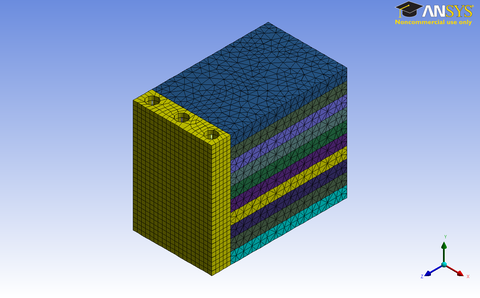 Note: This page has not been verified by our editors.
Note: This page has not been verified by our editors.
| Background | |
|---|---|
| Benchmark ID |
batteryPack_n151642m10q10 |
| Category |
misc |
| System-Class |
AP-LTI-FOS |
| Parameters | |
| nstates |
151642
|
| ninputs |
10 |
| noutputs |
10 |
| nparameters |
2 |
| components |
A, B, C, E |
| Copyright | |
| License |
Creative Commons Attribution 4.0 International |
| Creator |
Lucas Kostetzer (CADFEM) |
| Editor | |
| Location | |
1 Motivation
Due to the increasing interest in electromobility detailed knowledge about the thermal system behavior of complete battery packs becomes crucial [1]. Many aspects like power performance and aging characteristics depend on the temperature of the system. Thus the use of reduced models is important for a fast simulation of the system behavior over a long period of time.
2 Description
The battery pack consists of 10 cells and a water-cooled plate . The model has been generated and meshed in ANSYS. SOLID90 elements have been used for the finite element discretization of the battery cells. The flow problem has been modeled by FLUID116 elements, representing a one-dimensional pipe flow. Thereby SURF152 elements have been used to realize the convection between fluid and cooled plate. Thermal radiation and convection between battery pack and environment are neglected. The contact between the individual battery cells and between cells and cooled plate has been modeled with the help of the elements CONTA174 and TARGE170.
The ambient temperature as well as the fluid temperature at the entrance of the pipes has the given value of 0°C.
3 Data
The parametric system of order  with
with  inputs and
inputs and  outputs is of the following form
outputs is of the following form
with

- capacity matrix 
- basic conductivity matrix 
- part of conductivity matrix arising from convection 
- part of conductivity matrix arising from heat flux 
- input map 
- output map 
- state vector (temperature) 
- input vector (heat generation rate of each battery cell) 
- output vector (temperature at the center of each battery cell)
where  is the heat transfer coefficient and
is the heat transfer coefficient and  is the mass flow in the pipes (FLUID116 elements with load heat flux).
is the mass flow in the pipes (FLUID116 elements with load heat flux).
All matrices can be downloaded from Zenodo. The battery pack is a benchmark for problems containing unsymmetric matrices.
In the original model the values  and
and  for the parameters have been used.
for the parameters have been used.
4 Origin
The model was created in ANSYS by Lucas Kostetzer (CADFEM). The export of the system matrices from ANSYS and the documentation for MOR Wiki were performed by Julia Vettermann.
5 Citation
To cite this benchmark, use the following references:
For the benchmark itself and its data:
@misc{dataBatteryPack,
author = {Lucas Kostetzer and Julia Vettermann},
title = {Battery pack},
howpublished = {hosted at {MORwiki} -- Model Order Reduction Wiki},
year = 2024,
doi = {10.5281/zenodo.10820678}
}
6 Reference
- ↑ Geppert, Michael: "Entwicklung einer Werkzeugkette für die Erstellung reduzierter thermischer Modelle für Batteriepacks", diploma thesis, Institute of Automotive Technology, Technische Universität München, Munich, Germany (2010).


